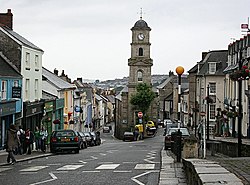Penryn
| Penryn | |
| Cornwall | |
|---|---|
 St Gluvias Street, Penryn | |
| Location | |
| Grid reference: | SW782345 |
| Location: | 50°10’8"N, 5°6’25"W |
| Data | |
| Population: | 6,227 (2001) |
| Post town: | Penryn |
| Postcode: | TR10 |
| Dialling code: | 01326 |
| Local Government | |
| Council: | Cornwall |
| Parliamentary constituency: |
Truro and Falmouth |
Penryn is a small town in Cornwall on the Penryn River about a mile northwest of Falmouth. The population was 7,166 in the 2001 census.
The name is form the Cornish language Pennrynn meaning 'promontory'.
Although latterly overshadowed by nearby Falmouth, Penryn was once an important harbour in its own right throughout the mediæval period exporting granite and tin.
History
Early history
Penryn is one of Cornwall's most ancient towns with a wealth of history. These lands appear in Domesday Book under the name of "Trelivel".
Penryn was founded as a town in 1216 by the Bishop of Exeter. The borough was enfranchised and its Charter of Incorporation was made in 1236. The contents of this Charter were embodied in a confirmation by Bishop Walter Bronescombe in the year 1259.[1] In 1265, a college, called Glasney College was built in Penryn for the Bishop of Exeter to develop the church's influence in the far west of the diocese.
In 1374, the chapel of St Thomas (sometimes called St Mary's) was opened. Standing at the head of the Penryn River, Penryn occupies a sheltered position and was a port of some significance in the 15th century.

After the Dissolution of the Monasteries by Henry VIII, Glasney was dissolved and the buildings demolished in 1548 under the authority of Prince of Edward, the first Protestant Duke of Cornwall, afterwards King of England. The dissolution of Glasney College helped trigger the Prayer Book Rebellion of 1549. The loss of Glasney and the defeat of the 1549 rebellion proved to be a turning point in the history of the town from which Penryn has never recovered.
Though fierce for the "Old Religion" in 1549, Penrhyn as with the rest of Cornwall later wholeheartedly embraced the Reformation and in due course supported the Puritans in the Church of England and later became a heartland of the non-conformist evangelical churches.
Later history
By the mid 17th century the port was thriving with the trade in Cornish fish, tin and copper. However, Penryn lost its custom house and market rights to the new town of Falmouth as a direct result of supporting the Parliamentary side in the Civil War]] (1642–48). The Killigrews of Arwenack were more skilful turncoats, and as their new town grew so the older port of Penryn declined from the 17th century right up to today.

From 1554, Penryn was a borough returning two members to the House of Commons; one of the many tiny boroughs in Cornwall. This ended in 1832.
The borough received a royal charter in 1621, mainly in a bid by the crown to cure the town of piracy. At least three mayors of Penryn were convicted of piracy between 1550 and 1650. The arms of the borough of Penryn were Sable a Saracen's head Or in a bordure of eight bezants.[2]
In the early 19th century, granite works were established by the river and large quantities of the stone were shipped from its quays for construction projects both within the British Isles and abroad.
The A39 road, which begins in Bath in Somerset and is about 200 miles long, once passed through Penryn towards the end of its route in nearby Falmouth, but a bypass was built in 1994.
Penryn today


Today, Penryn is a busy town and has managed to retain a large amount of its heritage. With a large proportion of its buildings dating back to Tudor, Jacobean and Georgian times, the town has been designated as an important conservation area. The local museum is housed in the Town Hall. Penryn has a small but active Rotary Club.
Sport
- Football: Penryn Athletic FC
Outside links
| ("Wikimedia Commons" has material about Penryn) |
References
- ↑ Roddis
- ↑ Pascoe, W. H. (1979). A Cornish Armory. Padstow, Cornwall: Lodenek Press. p. 134. ISBN 0-902899-76-7.
- Roddis, Roland, Penryn, The History of an Ancient Cornish Borough, 1964
- Warmington, Ernie:
- Penryn: People, Places, Postcards, Photographs, 1998, Published by the author, reprinted 2007
- Around Penryn (Images of England series), Stroud: Tempus Publishing, 2000, ISBN 0-7524-2098-4
- Penryn Revisited, Stroud: Tempus Publishing, 2007, ISBN 978-0-7524-4607-3
- Penryn Through Time, Amberley Publishing, 2010, ISBN 978-1-84868-543-7